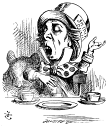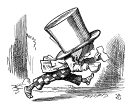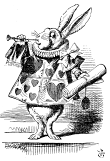Search us!
Search The Word Detective and our family of websites:
This is the easiest way to find a column on a particular word or phrase.
To search for a specific phrase, put it between quotation marks. (note: JavaScript must be turned on in your browser to view results.)
Ask a Question! Puzzled by Posh?
Confounded by Cattycorner?
Baffled by Balderdash?
Flummoxed by Flabbergast?
Perplexed by Pandemonium?
Nonplussed by... Nonplussed?
Annoyed by Alliteration?

Don't be shy!
Send in your question!
Columns from 1995 to 2006 are slowly being added to the above archives. For the moment, they can best be found by using the Search box at the top of this column.
 If you would like to be notified when each monthly update is posted here, sign up for our free email notification list.
If you would like to be notified when each monthly update is posted here, sign up for our free email notification list.
Trivia
All contents herein (except the illustrations, which are in the public domain) are Copyright © 1995-2020 Evan Morris & Kathy Wollard. Reproduction without written permission is prohibited, with the exception that teachers in public schools may duplicate and distribute the material here for classroom use.
Any typos found are yours to keep.
And remember, kids,
Semper Ubi Sub Ubi
|
Readme
If you are a regular reader, you will have noticed that I finally bit the bullet and reorganized my front page to make it less confusing. I rather liked the baroque look myself, but the complaints were beginning to wear me down. The new look seems a bit dull to me, but, then again, it’s only temporary. Once I master the new “active html” and “layering” technology, I’ll be able to re-do the page so that it’s entirely illegible again. And then I’ll define my page as a “push channel” so it’ll show up on your computer whether you want it to or not. My ultimate goal is to enable my page to follow you down the street whistling a menacing tune, rather like Robert Mitchum in “Night of the Hunter.”
Certain people have asked whether the photograph of me on my front page is, in fact, a photograph of me. Yes it is. I like this picture because it makes me look a great deal smarter than I usually do, makes my nose look almost normal, and, since it is a still photo, renders my usual eerie torpor nicely moot. That eyebrow thing takes years of practice, by the way. In the picture, taken with a quickcam atop my computer, I am gazing out onto glamorous West 82nd Street, hoping for a glimpse of the amateur ecdysiast across the way whilst, since lunchtime is nigh, pondering possible pigeon recipes.
Wale tale.
Dear WD: What can you tell me about “wales,” as in “wide-wale corduroy”? Are these “wales” somehow related to Wales, the country? — Tarara Boumdier, Brooklyn, NY.
As one whose ancestors came from “Wales, the country,” I consider myself singularly qualified to answer your question. The answer is no — there is no relation between Wales, the country, and “wales,” the ridges characteristic of corduroy fabric. And after investigating the origin of fabric “wales,” I’m glad there isn’t, because thereby hangs a rather grisly tale.
The original sense of “wale” (in the Old English form “walu”) was “the mark of a lash” — the welt or stripe raised on flesh by whipping, a sense which survives today in the related form “weal.” The English word “wale” eventually came to be applied to almost any sort of ridge, band or stripe, from stone fences to the strip of wood around the top of a boat’s sides, now usually called the “gunwale” (pronounced “gunnel,” by the way).
Speaking of corduroy, this humble fabric has some surprising origins of its own. The word “corduroy” is an Anglicization of the French phrase “corde du roi,” or “cord (cloth) of the king.” Corduroy cloth was originally developed as a durable material from which to fashion the hunting togs of French kings, the heavy ribbed cloth designed to withstand the rigors of the brush. The corduroy of the French royalty was a bit fancier than the stuff we wear today: just for starters, it was made of silk.
Meanwhile, back at “Wales, the country,” that name comes from the Old English word “Wealas,” meaning “foreigner.” The name embodies a certain objectionable arrogance inasmuch as it was first applied to the native Celtic peoples of Britain by the Anglo-Saxons, who were themselves invaders of the British Isles. The Welsh themselves call their country “Cymru.”
Nibs nabbed.
Dear WD: My father is curious about where the term “his nibs” came from. He has often said “his nibs” when referring to a friend or one of my brothers. I told him about your column and promised to write. I hope you can help. — Sandra Sheldon, Pittsburgh, PA.
Tell your father that he’s lucky I have a persistent streak. The Oxford English Dictionary, usually the definitive word on origins, defines “his nibs” as “an employer, a superior; a self-important person.” But as to the genesis of the phrase, the OED closed the door politely but firmly with the comment “origin obscure.” Undeterred, I decided to forge on in my quest — after all, some of my best friends have obscure origins.
Another hour or two among my trusty and dusty reference books produced not just the origin of “his nibs,” but interesting connections to several other words as well. “His nibs” was a common slang phrase among English college students in the 19th century, usually a sarcastic reference to someone seen as aloof or stuck-up. Along with an earlier form “nabs,” “nibs” was based on “nob,” an alternate spelling of “knob” and an 18th century slang term for “head.” The “head” in question was both literally the human head and “head man,” or an important person.
“Nab” was also a slang term for “hat,” and the verb “to nab” may be related to the same root, in the sense of “capturing the head” of someone. Some of the uncertainty about “nibs” and its relatives is due to their being filtered through 17th century thieves’ cant, where meanings were often deliberately obscured to confuse the police.
|
Makes a great gift! Click cover for more.  
400+ pages of science questions answered and explained for kids -- and adults!
FROM ALTOIDS TO ZIMA, by Evan Morris
 
|


 can be found
can be found 




Recent Comments